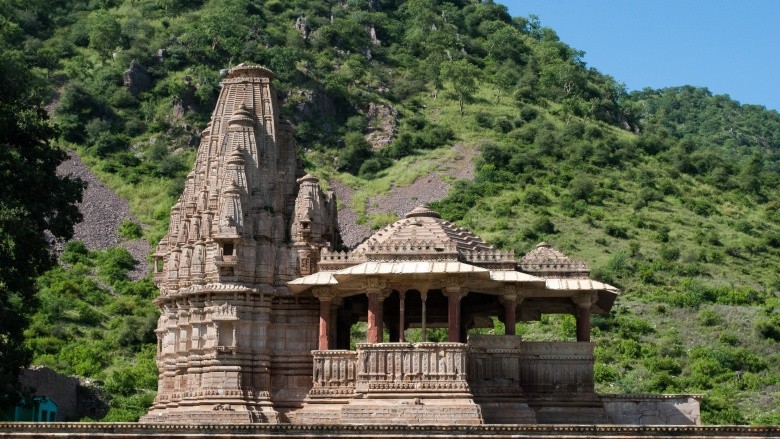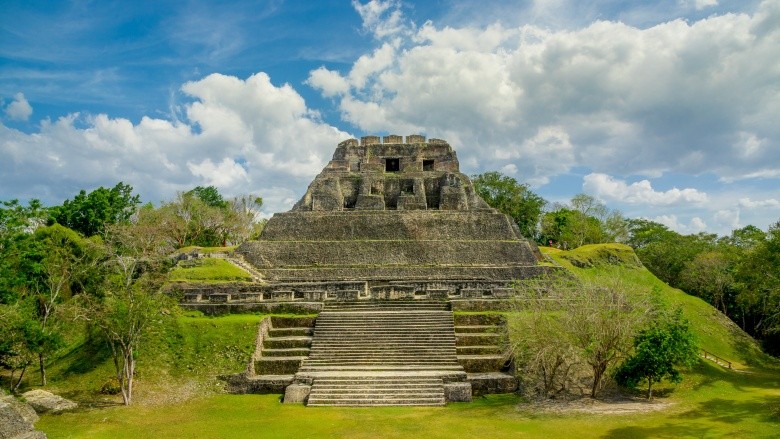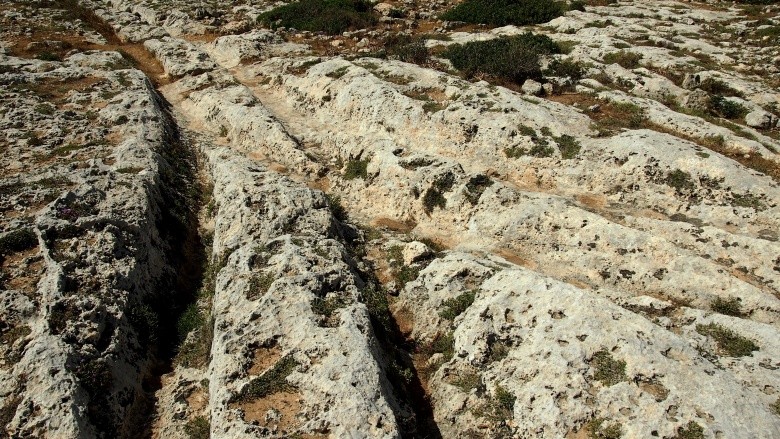Creepiest Stories From Lost And Abandoned Civilizations
Human history is brimming with harrowing tales of abandoned and lost civilizations that still haunt us, and even the most ardent of skeptics would be hard-pressed to explain away some of these creepy stories. From evidence of ancient unknown lifeforms to ghosts and elves, these stories are sure to send some shivers down your spine.
Roanoke Colony
There've been many civilizations to vanish without a trace throughout history, but the story of the Lost Colony of Roanoke is definitely one of the strangest. The American settlement in what is now North Carolina was home to about 100 people before Governor John White took off to England in search of supplies, in 1587. White's return was delayed due both to harsh travel conditions and Queen Elizabeth I's stay of shipping during the Anglo-Spanish War, so when he finally did reach his former homestead in 1590, he was surprised to find the entire place had been emptied with no sign of struggle. Only a wood carving with the word "CROATOAN" offered any a clue as to where they'd gone.
White thought the missing people — which included his daughter and baby granddaughter — may have relocated to the Croatoan Island, as it was just 50 miles away. However, weather conditions prevented him from searching for them. (A later search revealed none of them there, either.) White returned to England, never knowing the fate of his family. Some theorists believe they may have been absorbed into a local Native American tribe called the Croatans, and later archaeological findings at Hatteras Island supported that assumption. However, their survival is still not known for certain, and remains such a mystery that, according to the IB Times, it's thought to be partial inspiration for American Horror Story's sixth season plot.
Sanzhi
In this creepy story, developers of New Taipei City, Taiwan thought they were making the vacation resort of the future when they broke ground on their Sanzhi District UFO-style housing units. Then things went south very quickly. Legend has it that the construction crew destroyed a ceremonial Chinese dragon and, in doing so, awakened a curse that caused several fatal car accidents and suicides.
Another popular theory is that they built the homes right on top of a centuries-old Dutch soldier burial ground, and the angry spirits haunted the sites, thus leading to the project's abandonment. A designer behind the buildings later denied that it was ghouls which scared them away, and suggested it was simple bankruptcy that left the place unfinished, but the spookiness of the empty structures could not be contested. The structures, which had become something of a curious tourist hotspot, were demolished in 2010.
Nan Madol
The spiritual city of Nan Madol in Micronesia is the only ancient civilization built entirely on coral reefs. The site's construction, which consists of giant stones, is such a mystery that archaeologists have yet to explain how its settlers managed to lug such giant materials across the sea to build it. In fact, efforts to recreate a raft carriage of the sizable basalt logs with which it was made have sunk ... literally.
Local legends say that a pair of sorcerer brothers named Olosohpa and Olosihpa used magic to fly the pillars in and create their new ritual hub. Even today, the neighboring community which "owns" the long-deserted area — the Pohnpeians — considers it sacred and says spirits are the only present rulers of the abandoned island. According to them, any brave nighttime explorers will either die or go insane.
Helike
Poseidon's wrath has been attributed to many disasters in ancient lore, but none were quite as devastating as the 373 BC demolishment of Helike, Greece. The city's population was completely wiped out by an earthquake and tsunami submerging the entire place, shortly after "immense columns of flames" supposedly appeared in the city whilst animals fled. The ancients attributed the catastrophic destruction to the Greek god's rage over Helike people refusing to give their statue of Poseidon to Ionians in Asia.
That very same statue, the philosopher Eratosthenes would later write, was spotted standing under the sea, and created a hazard for fishermen using nets in the area. Helike's horrifying history may have even inspired Plato's story of the Lost City of Atlantis, which suffered a similar fate in his account. The city was re-discovered by archaeologists in 2001.
Bhangarh
Said to be India's most haunted place, the empty city of Bhangarh is not officially open to nighttime visitation in the modern era because, as legend has it, anyone who stays the night in the abandoned city will not make it through to morning. That may sound like some fictional plot of an eerie horror flick, but for locals, the ghosts that torment the place are very real.
According to one piece of creepy lore, the village — built in 1573 and eventually abandoned in 1783 — was cursed by a holy man whose view was obstructed by the height of the city's palace, which he'd warned its constructors not to do. Others believe it was a lovestruck wizard who condemned the city after his plot to cast a love spell on its princess was foiled. In either case, extreme paranormal activity — from the sound of phantom screams to strange smells — has been reported at the site, and people remain wary of testing the suggestion that nobody go exploring after sunset.
Angkor Wat
Even though the grounds of the Capital Temple of Cambodia have become something of a haven for monks and tourists alike in modern times, it's still rumored to house deep spiritual presences, and even a possible connection to ancient alien lifeforms. Visitors to the site have reported witnessing strange lights and noises and even encountering ghosts, which may or may not belong to the Khmer warriors who once resided there.
The giant city was erected between 800-1100 BC to honor the Hindu deity Vishnu, and became the largest of its time with up to a million people living within its elaborate structures. However, its residents suddenly and mysteriously vanished in the 15th century, and the massive site was left untouched until its rediscovery in 1860. Many people may make way to Angkor Wat to take in the scene by day, but at night the only souls who stick around are monks and nuns ... and whoever (or whatever) is still haunting the place.
Shin-Au-Av
According to Native American Paiute legends, there's a 5,000-year-old underground city that used to house an unknown race of giant people called the Shin-Au-Av. This legendary "Ghost Land" was said to have been discovered by a widowed chief, who grievously chose to live out his days in the desert and came upon a cave system. Forging through various spirit encounters within it, he eventually found the kingdom of Shin-Au-Av in the Land of the Dead and was even reunited with his wife with the warning not to look back. Sadly, he did, and her spirit disappeared forever.
In the 1920s, an Indian guide claimed to have fallen through the ground and into a catacombs system, wherein he discovered an ancient society of people. Then, in 1947, a retired ,physician-turned-explorer, named Dr. F. Bruce Russell, claimed to have come across a cavernous tunnel system that contained the mummified bodies of nine-foot-tall men who were cloaked in unrecognizable animal furs, as well as a giant ritual hall that served as a burial ground for the tribe's most important people. Though few people believed him, Dr. Russell stood by his story, and even organized investors to retrace the site's location ... until he mysteriously disappeared in the desert himself, that is.
Amarstapi
The abandoned fishing village of Amarstapi, Iceland may not be home to people anymore, but it's not exactly deserted, if the local legends hold true. According to natives, the village countryside has been reclaimed by the Huldufolk — or hidden elves — that occupy the various rock formations of the island nation.
Belief in the Huldufolk is still very serious business in Iceland. It's been the source of many construction halts (spurred by accidental deaths, no less) associated with developers attempting to move the sacred rocks that these elves call home. According to one folklorist, the Huldufolk "are seen as friendly, beautiful creatures, but you have to respect them, or they will take their revenge." One such revenge supposedly occurred in 2011, when construction workers experienced a bevy of equipment failures before an explosion sent rocks raining down on nearby residences. Fortunately, no one was hurt (or even around) during the incident, but locals believed it was a warning of the rage of the elves whose mountain was being mined at the time.
Maya
The disappearance of the advanced, sophisticated Mayan civilization is one of the world's most vexing mysteries, so explorers are constantly searching for clues as to what exactly happened. In the process of discovering details about the Mayans' lives, there've been some creepy findings about their deaths, too.
In 2014, explorers entered a fabled Mexican sinkhole (after asking permission from the gods, of course) and discovered a vat of human remains whose deaths could not be determined from the bones themselves. Scientists posited that perhaps they were 8th century plague victims who were thrown to their eventual demises, but local legends would have it that they were grabbed by the horse-headed serpent that villagers still fear.
It's not the only site that's said to be riddled with otherworldly activity. The Xunantunich ruins in Belize are also believed to be haunted by a stone woman in a white dress, with glowing red eyes — so much so that the name itself is a Mayan translation of the words "stone woman." In 2016, a tomb containing human remains was discovered within the structure ... but it was of a man's body. Even so, locals believe the female spirit that's been sighted there may have been a woman sacrificed at its ancient altar, which would explain why she's always seen descending the stairs, as she would've likely been killed at the top of the temple.
Phyrgian Valley
Turkey's Phyrgian Valley was the source of an unsettling finding, when a series of impossibly giant ruts were discovered. Russian geologist Alexander Koltypin controversially attributed the inexplicably deep and old (as far back as 12-14 million years) markings to an ancient intelligent civilization — possibly not people — that had the technology to drive vehicles across the landscape of the realm. "I think we are seeing the signs of a civilization which existed before the classic creation of the world," he said. "We're not talking about human beings."
Similar "cart ruts" had previously been discovered in Misrah Gahr il-Kbir in Malta and also defied logical archaeological explanation, leaving theorists to believe that ancient civilizations did indeed have advanced methods of transportation that have been preserved by nature for the modern world to observe. "We are dealing with some kind of cars or all-terrain vehicles," said Koltypin of the Turkish sister site. The mystery of these ancient cart ruts is as befuddling, and indicative of a potential alien presence in Earth's past, as the Nazca wheel lines, Stonehenge, and the Pyramids of Giza themselves. Creepy stuff, guys.





